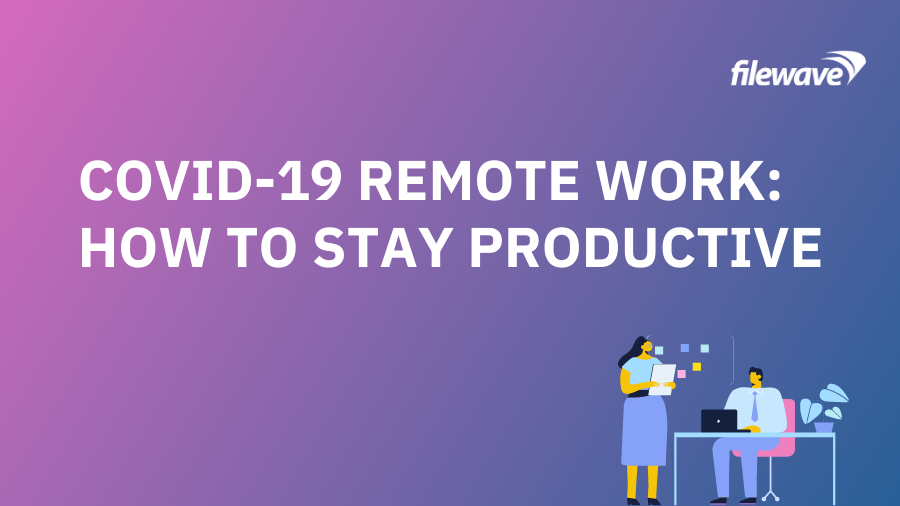With the rapid switch to remote work under COVID-19, many employees are using personal devices or devices misconfigured for remote work. Here’s how to keep IT on track.
Mandatory remote work has, in a very short span of time, become the new ‘normal’ for organizations across the globe as employees self-isolate to reduce the spread of COVID-19. With a little creativity, a lot of patience, and some IT best practices, here are some simple tips to make it easier to support your new remote workforce.
Acknowledge Flexibility
The first step in organizing this temporary remote workforce is acknowledging that COVID-19 has introduced variables that are difficult to control. Many employees have children at home who need attention or who have competing demands on technology for school work. Many employees are also working at less-than-ideal workspaces.
As much as organizations want to support employee productivity, the first step is to admit that employees won’t be able to work at capacity and that the hours they do work may vary or be interrupted. Flexible work policies can help ensure that employees prioritize self-care as much as they prioritize work.
Deploy the “Must Haves” for Remote Work
COVID-19 left many organizations and employees unprepared for remote work. Many employees are using home devices, or newly purchased laptops, or have taken devices home that are configured to work only on corporate networks. Hats off to all the IT teams who have been fielding endless help desk queries and phone calls by employees trying to get their devices set up.
While you can’t send home a proper desk to all your employees working in hallways, garages, and on stacks of toilet paper, you can make sure your employees have everything they need on their laptops to do their work. Here’s a quick list of what you should be prioritizing on all these new devices:
- A business-grade VPN
- Password standards for devices and home routers
- Communication tools (VoIP, Slack, Zoom, etc)
- Automated back-up to corporate servers or cloud accounts
- Security software such as anti-virus, anti-malware
It is very likely that you will have to increase software licenses to accommodate new devices, or you can temporarily re-allocate software licenses from unused workstations to home computers.
Make Visibility a Top Priority
Once that initial “get online” fervor has passed, the first step for every IT team is to regain visibility over all the devices connected to the corporate network. Cybercriminals have not taken time off during this pandemic – in fact, they’re already taking advantage of it.
FileWave takes all this device complexity – who owns the device, where is it, who owns the apps, and where are the apps coming from? – and simplifies it. We offer the following tips to help regain visibility over the devices being used by your remote employees:
- Step 1: Take Stock – Through network discovery, FileWave lists the devices, applications, and users connected to your network. If you identify unknown devices as new employee BYOD devices, you can ensure they are properly added to your device management platform.
- Step 2: Identify and Remediate Non-Compliant Systems – Beyond identifying devices, you next need to identify if connected devices are compliant in terms of OS patching, applications, and settings. Rather than rely on employees to patch their own systems, a tool like FileWave sends patches directly to employee devices at an optimal time in the day to reduce impact on productivity.
Centralize Software Management
It is true that decentralized decision making can be a source for innovation and agility. In IT, decentralized decision making has the opposite effect, leading to visibility gaps, management complexity, increased cost, and software bloat. Central software management is a far simpler alternative – for IT and for employees:
- Simplified Deployment – In order to support remote work, FileWave allows you to create group profiles that ensure all employees have what they need to be productive. These groups make it easier to send software bundles or digital content, enforce password standards, or set up network, VPN, or email configurations for remote work for whole groups of very different kinds of workers.
- Self-Service – You won’t always know what employees need to be productive, but you can avoid them buying software on their own by setting up a Self-Service Kiosk filled with software you have vetted, purchased, and pre-configured to work instantly. Users can download software without assistance and be ready to work in a fraction of the time it would take to find and install their own solution – making approved content the path of least resistance.
- Remote Support – Most help desk tickets that come in are related to a device or application, so you can shorten your help desk resolution time with FileWave’s built-in remote control to easily navigate firewalls and NAT configurations to operate remote computers wherever they may be to diagnose, push fixes, or remotely train employees.
FileWave brings years of experience and best practices to the plate to help you set up and configure your new remote workforce. We can offer hands-on support to help you gain visibility over the devices in your network or deploy the software and configurations your employees need to work from home. Consider us your extra set of hands during this crisis.


